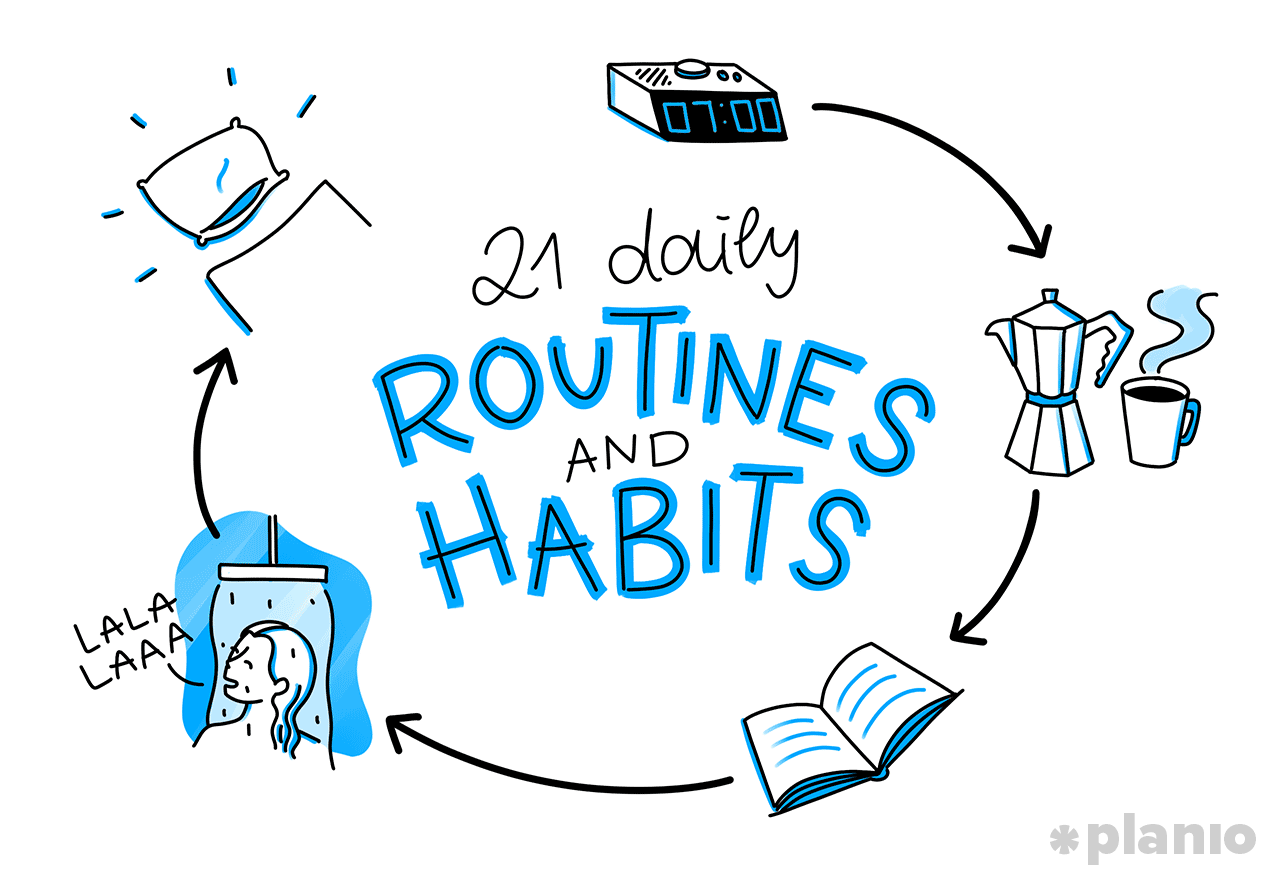Discover Pandipedia
Pandipedia is the world's first encyclopaedia of machine generated content approved by humans. You can contribute by simply searching and clicking/tapping on "Add To Pandipedia" in the answer you like. Learn More
Expand the world's knowledge as you search and help others. Go you!

Effective daily habits can significantly enhance productivity and wellbeing. Starting your day with a consistent morning routine, such as waking up early and incorporating physical activity, sets a positive tone. Engaging in practices like positive affirmations and mindfulness can further influence mood and decision-making throughout the day[1][2].
During work hours, respecting your energy cycles and taking regular breaks promotes better focus and reduces burnout[2][3]. Additionally, maintaining good hydration and practicing gratitude can contribute positively to mental and physical health[3][6]. Implementing these habits gradually will lead to lasting improvements in your daily life[4][5].
Let's look at alternatives:
- Modify the query.
- Start a new thread.
- Remove sources (if manually added).
- Request a manual search from our human research team.

Scotland generally has more rainfall than Ireland. The western highlands of Scotland are among the wettest places in Europe, receiving annual rainfall up to 4,577 mm (180.2 in), while some parts of Ireland can see annual totals exceeding 3,000 mm[1][2].
In terms of averages, Scotland receives the highest annual volume of rain in the United Kingdom, whereas rainfall patterns in Ireland can vary significantly, with the west coast receiving more rain than the east. Therefore, while both countries have rainy reputations, Scotland typically has a higher overall rainfall[2][4].
Let's look at alternatives:
- Modify the query.
- Start a new thread.
- Remove sources (if manually added).
- Request a manual search from our human research team.
Get more accurate answers with Super Search, upload files, personalised discovery feed, save searches and contribute to the PandiPedia.
Let's look at alternatives:
- Modify the query.
- Start a new thread.
- Remove sources (if manually added).
- Request a manual search from our human research team.
Eddie Cue is a key executive at Apple who has been involved in negotiations with Google regarding search agreements. He was part of discussions about the Apple Safari agreement in 2016 with Sundar Pichai and attended a meeting with Pichai in 2018 alongside Tim Cook and Peter Stern[2]. Cue has stated that Google was chosen as a search provider because it was perceived to be the best option for customers, although he acknowledged that alternatives like Bing faced significant disadvantages in quality[1][3]. Furthermore, he indicated that there wasn't a valid alternative to Google's services, reinforcing the idea that changing search engines was not considered to be in Apple's best interest[4][3].
Let's look at alternatives:
- Modify the query.
- Start a new thread.
- Remove sources (if manually added).
- Request a manual search from our human research team.
Mobile gaming is experiencing a decline[1] due to several factors, including market saturation, increased competition from other entertainment options, and the rise of alternative gaming platforms[1] such as cloud gaming, consoles, and PC gaming. These factors have led to decreased user engagement[1], retention, and revenue generation potential[1] for mobile games. As a result, the industry is facing significant challenges in maintaining its financial stability and market relevance[1]. However, the future of mobile gaming[1] could still hold potential for revival through innovations, niche market targeting, and the adoption of new technologies.
Let's look at alternatives:
- Modify the query.
- Start a new thread.
- Remove sources (if manually added).
- Request a manual search from our human research team.
Let's look at alternatives:
- Modify the query.
- Start a new thread.
- Remove sources (if manually added).
- Request a manual search from our human research team.
Get more accurate answers with Super Search, upload files, personalised discovery feed, save searches and contribute to the PandiPedia.
Documentary filmmaking uniquely blends factual storytelling with emotional engagement, making the crafting of narratives a critical aspect of the genre. Filmmakers utilize a range of techniques to effectively convey their messages while maintaining viewers' interest. The following sections explore some of the common narrative techniques employed in documentaries, highlighting the importance of structure, character development, visual storytelling, and emotional engagement.
The Importance of Narrative Structure
A well-defined narrative structure is essential for captivating an audience in documentary films. Many filmmakers adopt the three-act structure, which consists of a setup, confrontation, and resolution. This classic format helps to organize content meaningfully, guiding viewers through conflicts and ultimately resolving them, thereby providing closure to the narrative[2][3].
The setup introduces the topic, characters, and setting, laying the groundwork for the story. The confrontation presents the central conflicts or problems that the subjects face, creating tension and engaging the audience. Finally, the resolution ties up loose ends and concludes the story, offering insights or reflections that resonate with viewers[2][5].
Humanizing Characters

One potent technique in documentary storytelling is the humanization of characters. Filmmakers strive to create emotional connections between the audience and subjects by showcasing their personal stories and vulnerabilities. By allowing subjects to share their struggles and dreams, filmmakers can highlight the depth of their characters, making them relatable and engaging[2][5].
Capturing candid moments and everyday activities can further enhance viewer connection. Visual storytelling that involves simple actions, such as cooking or interacting with loved ones, can provide a deeper insight into the subjects' lives. Authenticity is vital, as overly scripted scenes may detract from the genuine portrayal the audience seeks[2].
Utilizing Visual Storytelling
Visual storytelling is at the heart of documentary filmmaking. It is about using images and footage to express emotions, ideas, and messages beyond what words can convey. By incorporating a variety of visual elements, filmmakers can create a more immersive experience for viewers. This includes not only primary footage but also B-roll (supplementary footage that enriches the narrative) and archive footage to provide historical context[1][3].
Filmmakers often rely on symbolic and metaphoric imagery to add layers of meaning to their narratives. The choice of visuals plays a crucial role in creating an emotional atmosphere and guiding the audience's understanding of the story[4]. Additionally, various cinematic techniques such as camera angles, framing, and lighting contribute to the documentary's overall impact[4][7].
Integrating Real-Time Footage and Interviews
Real-time footage can significantly add authenticity and immediacy to a documentary. Capturing events as they happen allows for an unfiltered experience, which can enhance emotional engagement. Coupled with well-executed interviews, filmmakers can provide insights into the subjects' thoughts and feelings, enriching the narrative[3][4].
Careful curation and editing of real-time footage are essential for maintaining a coherent narrative. This footage must align with other narrative elements like interviews and voiceovers, creating a seamless and dynamic viewing experience[3][2].
Establishing Emotional Arcs
Documentaries often employ emotional arcs to keep viewers invested in the story. By showcasing the highs and lows that subjects experience, filmmakers can create relatable and compelling narratives. Key moments of tension, conflict, and resolution should be highlighted to emphasize the emotional journey of the characters[2][5].
Moreover, the combination of voiceovers and sound design can evoke emotions throughout the film, reinforcing the narrative's themes and enhancing audience engagement. For instance, poignant music or sound effects can underscore significant moments and deep emotional beats within the story[3][4][7].
Balancing Fact and Emotion
Crafting a compelling documentary narrative requires a delicate balance between presenting factual information and emotional storytelling. Filmmakers often intertwine statistics, expert interviews, and personal anecdotes to engage the audience intellectually and emotionally[7]. This blending of fact and narrative not only informs viewers but also invites them to emotionally invest in the stories being told.
Maintaining Narrative Cohesion
The editing phase of documentary filmmaking is crucial for ensuring narrative cohesion and clarity. Editors select the best footage, arrange sequences for maximum impact, and ensure that the storytelling remains consistent and engaging throughout the film. This process often involves creating montages and utilizing techniques that support the documentary's central thesis[3][5][7].
Conclusion
In the realm of documentary filmmaking, narrative techniques adapt to span a spectrum from visual storytelling to character development. The blending of emotional engagement with factual integrity allows filmmakers to construct narratives that resonate deeply with audiences. By leveraging structures like the three-act framework, humanizing characters, and employing visual and auditory storytelling techniques, documentaries can inspire, educate, and evoke profound emotional connections, ultimately transforming real-life events into compelling cinematic experiences.
Let's look at alternatives:
- Modify the query.
- Start a new thread.
- Remove sources (if manually added).
- Request a manual search from our human research team.
Let's look at alternatives:
- Modify the query.
- Start a new thread.
- Remove sources (if manually added).
- Request a manual search from our human research team.
As Black Friday 2024 approaches, shoppers face the decision to either shop online or visit brick-and-mortar stores for the best deals. With each option presenting unique advantages and potential drawbacks, it's essential to evaluate where the best discounts can be found.
The Appeal of Online Shopping

Online shopping is rapidly becoming the preferred choice for Black Friday enthusiasts. This shift has been significantly influenced by the convenience and extensive variety available online. Major retailers like Amazon, Best Buy, and Walmart have initiated their sales well in advance of Black Friday, with many deals starting as early as October and extending through to December. Adobe Analytics suggests that the strongest discounts are anticipated between November 22 and Cyber Monday[10].
Retailers are increasingly offering exclusive online discounts that may not be available in-store, making early access to deals particularly tempting. For instance, many discounts on electronics, apparel, and toys are typically larger during this time, so shoppers can benefit from browsing multiple retailers at their convenience. Those savvy enough to explore deals across different platforms may find extensive selections including tech, home appliances, and everyday essentials[9][10].
Additionally, online shopping eliminates the struggle of navigating crowded stores. Shoppers can effortlessly compare prices and access special promotions without the pressure of in-store shopping. Many platforms now incorporate robust search functionalities, allowing consumers to filter products by category, price, and customer ratings, enhancing the shopping experience[11].
In-Store Shopping: A Traditional Experience
Despite the advantages of online shopping, in-store shopping still holds value, particularly for those who enjoy the tactile experience of examining products before purchasing. Black Friday is a pivotal event for brick-and-mortar retailers, many of whom use it to showcase their latest gadgets and offer extraordinary flash sales on specific items. Retailers such as Target and local appliance stores often have unique in-store promotions that may not be replicated online. For instance, many stores commence their sales on Thanksgiving or late at night on Black Friday, attracting shoppers eager for deals[10].
One of the main advantages of shopping in physical stores is the instant gratification of leaving with a product right away. Items like furniture, home goods, and large appliances often have dedicated displays that allow customers to evaluate them better in person. This is crucial for larger purchases, where seeing the product firsthand can provide buyers with a more informed decision[8].
Mixed Strategies: The Best of Both Worlds
A combined approach may provide the most comprehensive shopping experience. Shoppers can scout products online, reading reviews and comparing prices, before deciding whether to buy in-store or online. Insights gained from expert reviews and detailed evaluations of products can enhance informed decisions, ultimately leading to smarter purchases[1][7].
For example, the Independent highlights the significance of knowing when to shop for various items. Discounts on toys and sporting goods peak on Thanksgiving Day, while electronics typically feature the deepest discounts on Black Friday itself. Thus, planning a shopping strategy that encompasses both in-store and online sales to capitalize on specific promotional periods can yield significant savings[5][10].
Many retailers now recognize the importance of both online and in-store presence during the Black Friday craze. This duality is reflected in pricing strategies; for instance, retailers like Best Buy and Target often match online deals in-store, particularly for high-demand items such as gaming consoles and tech gadgets. This strategy underlines the urgency to check both venues to ensure the best savings[6][10].
Precautions and Considerations
While both shopping strategies have their merits, caution is essential in online transactions. Consumers are urged to double-check prices and ensure they are shopping from reputable sites to avoid scams or inflated pricing disguised as discounts. Using price tracking tools can help confirm that a deal is as genuine as it claims to be[9][11].
Finally, the traditional notion that Black Friday is the best day of the year for shopping is gradually evolving. With ongoing promotions and holiday sales continuing beyond Black Friday into December, consumers should consider waiting if the timing isn't right—especially for fashion and beauty items, which often see substantial discounts on Cyber Monday and throughout the holiday season[10][11].
In conclusion, whether opting for the comfort of online shopping or the traditional in-store experience, being well informed about the dynamics of Black Friday can lead to triumphant savings. Combining strategies, leveraging both physical locations and online platforms, and staying vigilant regarding offers can help consumers achieve a fulfilling holiday shopping experience.
Let's look at alternatives:
- Modify the query.
- Start a new thread.
- Remove sources (if manually added).
- Request a manual search from our human research team.

The Cold War was an ongoing political rivalry between the United States and the Soviet Union and their respective allies that developed after World War II[1][5]. This period was marked by a series of geopolitical tensions, characterized by competition and confrontation between communist nations led by the Soviet Union and Western democracies including the United States[3]. The term 'Cold War' was first used by George Orwell in a 1945 article to describe a nuclear stalemate between the superpowers[1][5].
After the surrender of Nazi Germany in 1945, the wartime alliance between the United States, Great Britain, and the Soviet Union began to unravel, leading to fears of permanent Soviet domination in Eastern Europe and the spread of communism[1][2]. This hostility solidified by 1947-48 when U.S. aid under the Marshall Plan brought Western Europe under American influence, and the Soviets established communist regimes in Eastern Europe[1][2][5].
The Cold War was predominately waged on political, economic, and propaganda fronts rather than through open warfare[1][3][5]. It included significant events such as the arms race, the space race, and proxy wars in regions like Korea and Vietnam[2][3][4]. It lasted until the fall of the Soviet Union in 1991, which led to the dissolution of the Eastern Bloc and the end of the Cold War[1][2][3][4][5].
Let's look at alternatives:
- Modify the query.
- Start a new thread.
- Remove sources (if manually added).
- Request a manual search from our human research team.